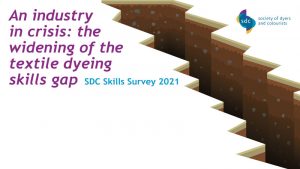 How can the textile dyeing industry collectively combat the current skills crisis?
How can the textile dyeing industry collectively combat the current skills crisis?
By Andrew Filarowski
Although anecdotal evidence exists showing the lack of critical skills and resources in the dyeing sector, recent research undertaken by the England-based Society of Dyers and Colourists (SDC) has found the true extent of the issue — and the results suggests that the industry really is now at a crisis point.
An overwhelming majority of industry players that took part in the SDC’s recent survey, “An Industry in Crisis: The Widening of the Textile Dyeing Skills Gap” stated that there is an international shortage of knowledgeable textile coloration professionals, with more than three quarters of respondents describing this as harmful to textile production and quality of product.
But what is causing the issue? It’s clear that fresh talent is not entering the profession as once was the case, with negative perceptions of textile dyeing as a dirty and hazardous industry being a key reason. This, combined with properly qualified staff retiring means that there is now a “squeezed middle,” stretched very thinly across the board.
Technical knowledge is also seen as hard to achieve and can sometimes be undervalued by employers, but it’s also true that people with the chemical expertise behind the dyeing process are the only ones able to innovate and bring the industry forward — achieving both quality excellence and sustainable operations.
SDC’s research also found that there is poor promotion of opportunities within the industry, and a lack of locally available training and support from employers in relation to learning and qualifications. SDC’s assumptions also were confirmed that there is a lack of traineeships available that offer qualifications in the science of fabric coloration.
Further to all of this, is the preference of textile students leaving higher educational institutions to become designers — rather than dyers with an interest in the practical side — and therefore a lack of understanding of how color is applied to fabric.
 Six Practical Steps
Six Practical Steps
So, how can the industry collective combat this skills crisis before it is too late?
Firstly, the industry must take a more practical approach to learning to allow a greater scope of candidates to enter the industry, such as earn and learn schemes and paid traineeships. This will allow people to continue to make a living while becoming qualified, thus opening up a wider talent pool.
Secondly, part-time online learning should be made available globally, making tuition more accessible to all within the sector. This accessibility is something that the SDC is spearheading, working with the industry to make courses available to all.
Thirdly, young people should be incentivized with higher starting salaries to bring chemists back into the fold, using their scientific knowledge to drive the industry forward. Whether that’s better-paid traineeships, or bonuses to join with prior qualifications in science or chemistry. The industry needs to reward skills accordingly.
The industry must also collaborate collectively to lobby governments to provide support and subsidized training — or at least to help promote textile dyeing as a career at a national level, and made known within schools as a viable and fulfilling career path.
In addition, dyers and employers should work together with training providers, with a two-way approach to information sharing, to ensure that courses are relevant, up-to-date, and applicable to the modern-day dyehouse. Those with considerable dyeing skills should also take up teaching and training positions to pass on their invaluable knowledge and experience to a new generation of dyers.
Lastly, dyehouses must engage with those further down the supply chain, such as fashion brands, to educate them on the importance of the dyeing process and how it can help improve their product to help change perceptions on the prospect of textile dyeing as a career. Fashion brands can help highlight the importance of knowledgeable dyers at this critical stage in the manufacturing process.
 Consequences Of Inaction
Consequences Of Inaction
Without qualified dyeing technicians, the industry will come to a standstill because knowledge and expertise will be lost permanently, higher processing costs will be incurred because of a lack in process innovation, which will result in inferior end products.
This paints a severe picture of what could happen if the talent crisis within the sector is not solved. Smaller dyehouses will be forced to shut their doors, and only larger operations with in-house training would remain — though with the scope of technical expertise severely narrowed.
Sustainability and efficiency also will be compromised, and a dyehouse’s ability to remain compliant with changing legislation will be compromised.
Ultimately, the industry must both take notice and take action to halt the widening of the skills gap and to bring science back into the equation.
Editor’s Note: Andrew Filarowski is deputy chief executive and technical director at the England-based Society of Dyers and Colourists (SDC).
May/June 2021




